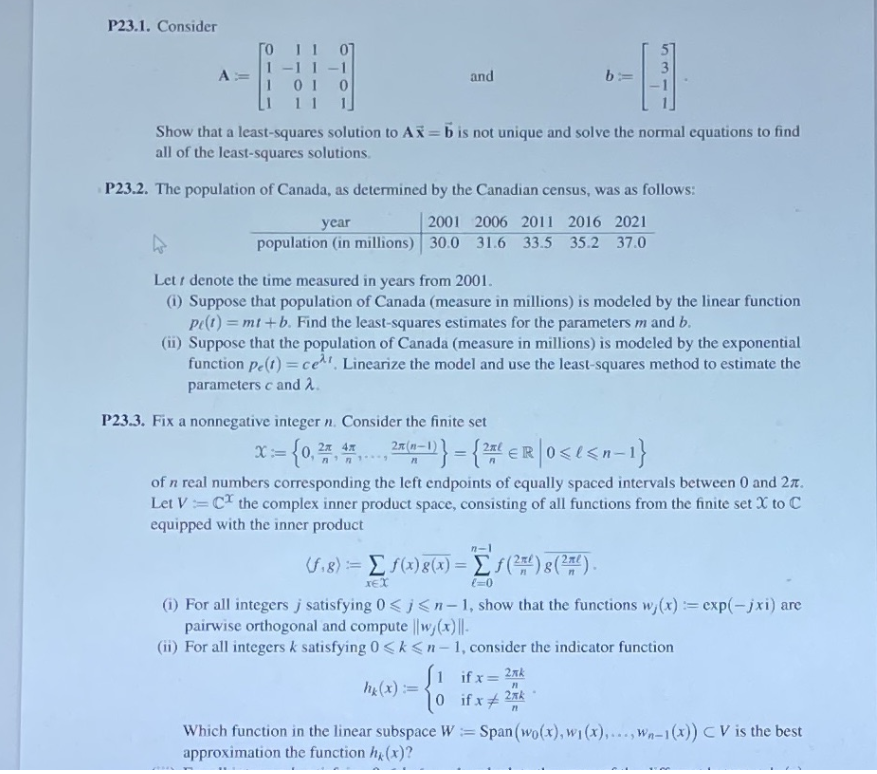P23.2. The population of Canada, as determined by the Canadian census, was as follows: year 2001 2006 2011 2016 2021 population (in millions) 30.0 31.6 33.5 35.2 37.0 Let t denote the time measured in years from 2001. (i) Suppose that population of Canada (measure in millions) is modeled by the linear function pe(t) = mt+b. Find the least-squares estimates for the parameters m and b. (ii) Suppose that the population of Canada (measure in millions) is modeled by the exponential function pe(t) =ce, Linearize the model and use the least-squares method to estimate the parameters c and 2
P23.2. The population of Canada, as determined by the Canadian census, was as follows: year 2001 2006 2011 2016 2021 population (in millions) 30.0 31.6 33.5 35.2 37.0 Let t denote the time measured in years from 2001. (i) Suppose that population of Canada (measure in millions) is modeled by the linear function pe(t) = mt+b. Find the least-squares estimates for the parameters m and b. (ii) Suppose that the population of Canada (measure in millions) is modeled by the exponential function pe(t) =ce, Linearize the model and use the least-squares method to estimate the parameters c and 2
Linear Algebra: A Modern Introduction
4th Edition
ISBN:9781285463247
Author:David Poole
Publisher:David Poole
Chapter7: Distance And Approximation
Section7.3: Least Squares Approximation
Problem 34EQ
Related questions
Question
(please solve question 23.2 within 15 minutes I will give thumbs up)

Transcribed Image Text:P23.1. Consider
To 1 1
A =
and
b3=
1 01 0
11
Show that a least-squares solution to Ax = b is not unique and solve the normal equations to find
all of the least-squares solutions.
P23.2. The population of Canada, as determined by the Canadian census, was as follows:
year
2001 2006 2011 2016 2021
population (in millions) 30.0 31.6 33.5 35.2 37.0
Let t denote the time measured in years from 2001.
(1) Suppose that population of Canada (measure in millions) is modeled by the linear function
pe(t) = mt +b. Find the least-squares estimates for the parameters m and b.
(ii) Suppose that the population of Canada (measure in millions) is modeled by the exponential
function pe(t) = ce, Linearize the model and use the least-squares method to estimate the
parameters c and 2.
P23.3. Fix a nonnegative integer n. Consider the finite set
27(n–1)
={0. } = {# eR|0<{<n=1}
X:=
2n 4x
of n real numbers corresponding the left endpoints of equally spaced intervals between 0 and 2z.
Let V=C the complex inner product space, consisting of all functions from the finite set X to C
equipped with the inner product
n-1
(Fi18) := E f(x)g(x) =Ef)8(#).
%3D
XEX
l=0
(i) For all integers j satisfying 0<j<n-1, show that the functions w,(x)= exp(-jxi) are
pairwise orthogonal and compute ||w,(x)|| -
(ii) For all integers k satisfying 0 <k <n-1, consider the indicator function
1 ifx= 2nk
0ifx#
%3D
he (x) :=
Which function in the linear subspace W=
Span (wo(x), w1(x),.., Wn-1(x)) CV is the best
approximation the function h (x)?
Expert Solution
This question has been solved!
Explore an expertly crafted, step-by-step solution for a thorough understanding of key concepts.
Step by step
Solved in 2 steps

Recommended textbooks for you

Linear Algebra: A Modern Introduction
Algebra
ISBN:
9781285463247
Author:
David Poole
Publisher:
Cengage Learning

Linear Algebra: A Modern Introduction
Algebra
ISBN:
9781285463247
Author:
David Poole
Publisher:
Cengage Learning